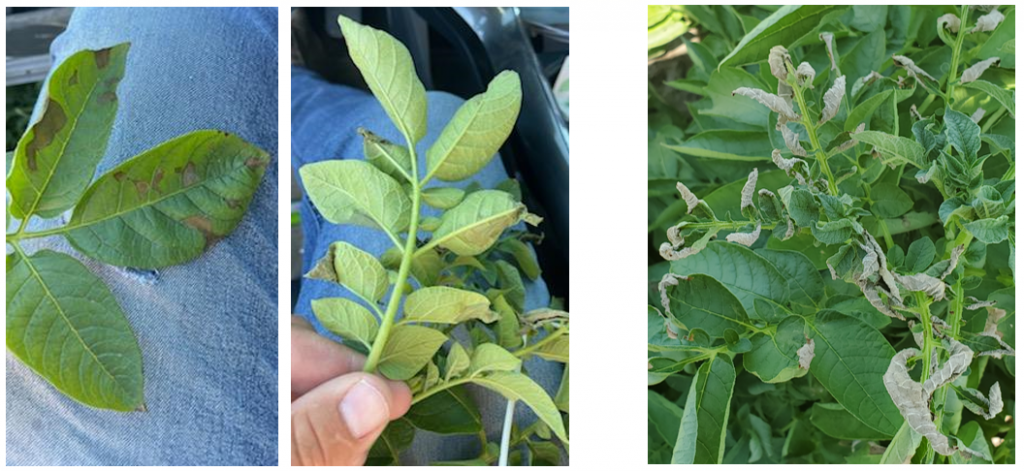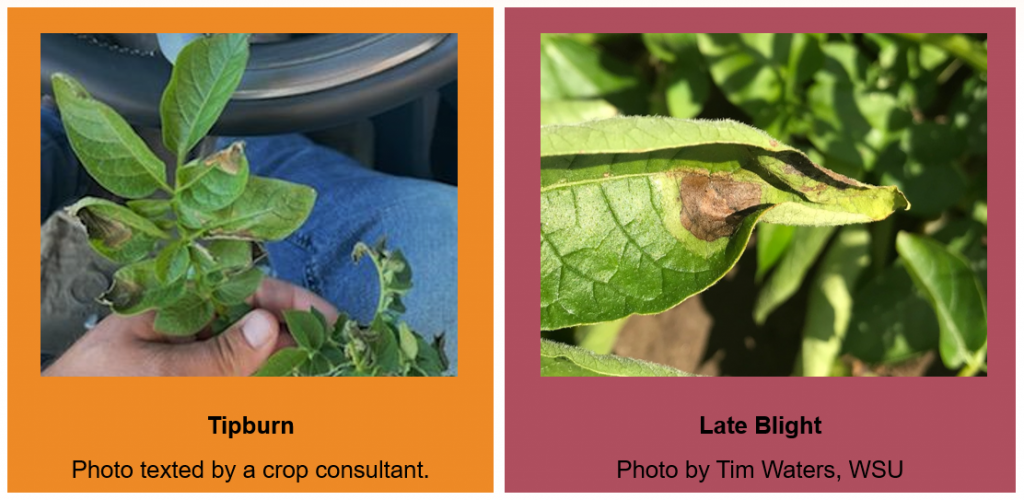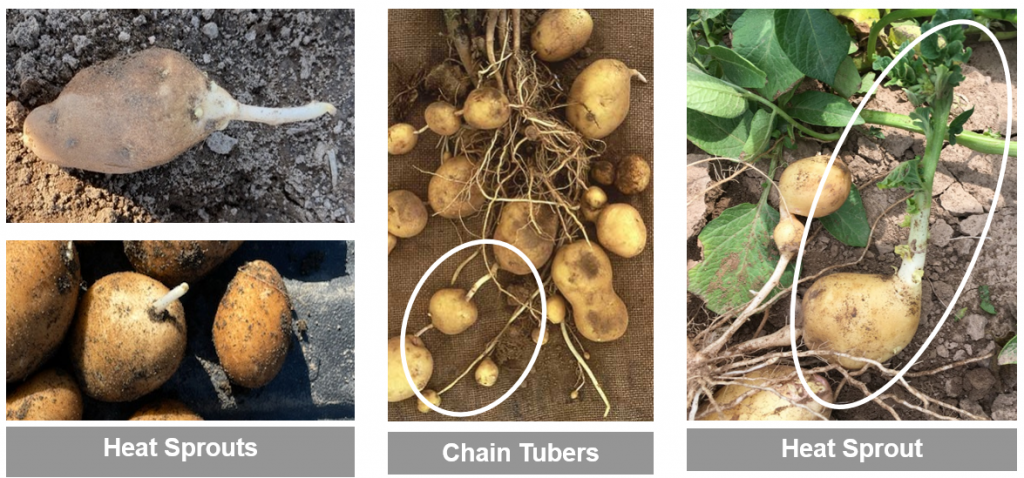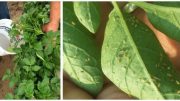|
Click to listen to this article
|
WSU POTATO ALERTS
HEAT STRESS
WHAT IS HEAT STRESS? Potatoes can suffer from heat stress when temperatures rise. Heat stress severity depends on (1) how hot it gets, (2) the rate of temperature increase, (3) how long extreme temperatures last, and (4) the water status of the crop and soil. Temperatures, at least 10 degrees F above normal, that spike suddenly and last a long time under draught conditions are the worst-case scenario.
FOLIAR SYMPTOMS
Most of the pictures of potato plants below were taken by Tim Waters and Carrie Wohleb, WSU Extension, during the extreme heat at the end of June 2021 (the infamous heat dome). They illustrate some of the heat stress symptoms we saw on potatoes then. You may see some of these symptoms as temperatures climb above 100 degrees F.

LEAF ROLLING is a common response to high temperatures. It starts with upward cupping of the leaf margins and then progresses to inward folding of the entire leaflet (like a taco). It’s a heat-avoidance response because leaf rolling reduces exposure to solar radiation. It can be temporary or permanent depending on the severity and duration of heat. The leaves may also become thick and leathery due to carbohydrate accumulation because heat stress can cause slow or reduced translocation of carbohydrates from the leaves to tubers.

LEAF SENESCENCE & DROP: Sometimes plants drop their lower leaves in response to heat and drought (see photo above left). It can be an “escape” strategy to conserve resources by decreasing canopy size. It’s most noticeable under extreme conditions of heat (and drought) stress; you may see this in the outermost rows where less water gets to the plants and the canopy is more open.
SMALL LEAVES: Potato leaves (and leaflets) that develop during high temperatures may be smaller (see photo above middle). This is a common plant adaptation in hot environments because small leaves are better at dissipating heat than large leaves.
WILTING can be considered a heat avoidance strategy because the drooping leaves expose less surface area to the sun (see photo above right). Why and how plants wilt is explained below.

TIPBURN (or windburn) can happen when parts of the leaf dehydrate under hot, dry, and windy conditions (see photos above left). It usually occurs at the leaflet tips and edges. As the damaged areas dry, they become necrotic and brittle (see photo above right).

Tipburn symptoms can resemble late blight. Here’s how to tell them apart… Tipburn is uniformly brown with abrupt margins between healthy and damaged tissues. Late blight lesions often include necrotic areas surrounded by a chlorotic margin. Tipburn usually occurs at the field edges or on plants most exposed to sun and wind. Late blight is almost always clustered into hot spots, typically in low spots or wetter parts of the field. Tipburn symptoms do not spread from plant to plant. Late blight is caused by a pathogen (Phytophthora infestans) that spreads rapidly to neighboring plants; it’s unusual to find symptoms on just one plant.

HEAT CRINKLE: When temperatures are extremely high, in addition to producing small leaves, the new leaves can be cupped, distorted, or crinkled, and they may be yellow or have a yellow-green mosaic because of chlorophyll degradation. This disorder is sometimes called “heat crinkle”. It can resemble herbicide injury, and at the cellular level, the damage caused by high temperatures is probably similar to the damage done by some herbicides. Plants on the edges of the field or at the ends of rows are more likely to exhibit these symptoms because they are not as protected by neighboring plants, are more exposed to the sun, and may get less water. We have only seen these symptoms during extremely high temperatures (above 105 degrees F).

TOXIC SEED PIECE SYNDROME (TSPS) is a poorly understood disorder that allegedly results when breakdown products from the seed piece are transported up the vascular tissue to the leaves. Pathologists have not been able to specify a causal agent. TSPS tends to show up in Columbia Basin potato fields when the weather suddenly turns hot.
The photos above show TSPS symptoms. Interveinal bronzing of the leaves is often followed by wilting of the plant stem. The wilted stem remains standing rather than flopping over. When you dig up the plant, the seed piece is usually gone or is a gelatinous, brown, translucent remnant. There should be no rotten odor. The vascular tissue is usually discolored from the seed piece attachment and often extends high up the stem. Plants with TSPS will be randomly distributed in the field instead of grouped; this pattern is typical of diseases and other problems brought in on seed. Incidence is typically only 1% of all plants. TSPS does not spread to nearby plants.
TUBER SYMPTOMS

HEAT SPROUTS or heat runners, are one outcome of a physiological disorder known as “second growth”. High soil temperatures (with or without soil moisture deficit) can temporarily pause tuber development. When growth resumes, instead of continuing to expand the tuber, it produces a sprout. The heat sprout will either grow into a leafy above-ground stem or another tuber (a chain tuber).
MISSHAPED TUBERS: The slowing and resumption of growth that disrupts tuber expansion can also result in tubers with bottleneck or dumbbell shapes and knobs.

PINK EYE is a physiological disorder associated with high soil temperature and excessive soil moisture. Those conditions create an anaerobic condition around the tuber. The lack of oxygen with heat impairs the development of epidermal cells, so they can’t produce normal periderm (skin). Another name for pink eye is “periderm disorder syndrome”. It’s called pink eye because early symptoms usually involve a pink discoloration around the eyes (see photo above left).
Click HERE for more information about pink eye. It was featured in an issue of WSU Potato Alerts last season.
HOW POTATOES ACCLIMATE TO HEAT
ACCLIMATION TO HIGH TEMPERATURES: Potatoes and other plants acclimate to rising temperatures via biochemical changes, and through morphological (structural) or physiological (functional) modifications. These changes help plants tolerate high temperatures, or they help plants avoid or dissipate heat.

HEAT SHOCK PROTEINS, which occur in all living things, stabilize other proteins when exposed to high temperatures, so they don’t aggregate into a tangled mess, enabling proteins to resume their normal function when the stress abates. Increased production of these proteins and other things like antioxidants and osmoprotectants are biochemical responses to high temperatures.
CHANGING LEAF ORIENTATION & ROLLING are common morphological responses to high temperatures. Changing how leaves orient to the sun, so they are less exposed, is a heat avoidance strategy.
MODIFYING LEAF CUTICLE WAX: Plants growing in cool, cloudy, or shaded conditions tend to produce leaves with a thin and clear cuticle layer, leaving them tender and easily desiccated. Hardened leaves acclimated to sun exposure have a thicker cuticle to protect against dehydration, and the cuticle may be more opaque to reflect some sunlight.
TRANSPIRATIONAL COOLING is the physiological process of moving water through the plant, driven by its evaporation from leaves. It’s an important heat-mitigating strategy of plants because heat is carried off as water changes from a liquid to a vapor state. Think of it as “plant sweat”. This evaporative cooling process can be highly effective when soil moisture is adequate.

IRRIGATING DURING HEAT WAVES
Potatoes in the Columbia Basin average some of the highest yields in the world. However, some aspects of the region’s climate are far from ideal for growing potatoes. Annual precipitation is only 8-10 inches per year. Daily air temperatures are almost always higher than 90 degrees F in July and August, and there can be several weeks with highs above 100 degrees F.

IRRIGATION IS IMPORTANT: Irrigation makes potato production in the Columbia Basin possible. It has the advantage over rainfall of supplying precise amounts of water to the crop exactly when and where it’s needed, and it’s essential for cooling the plants and mitigating heat stress when temperatures are high.
EVAPOTRANSPIRATION (ET) estimates the amount of water that moves into the atmosphere via the combined processes of evaporation and transpiration. It’s useful for estimating crop water use and scheduling irrigation. Crop ET rates can increase dramatically when temperatures rise, so it’s good to look at weather forecasts and crop ET charts when heat waves are expected.
WSU’s AgWeatherNet (AWN) estimates ET rates for more than 40 crops, including potatoes. The system calculates a reference ET for alfalfa using the Penman equation (incorporating temperature, wind speed, air pressure, and solar radiation data recorded at weather stations). This is multiplied by a crop coefficient, that relates to the crop at its current growth stage (adjusted for ground cover), to estimate crop ET.
AWN offers several tools to help with irrigation, but I recommend starting with the “Water Use” model. From the AWN home page, select “Models”, then “Irrigation”, then “Water Use”. Choose a weather station from the menu, and input a date range (past or future dates). Click on the “Selected Crops” button and check “Potatoes” and then “Custom Emergence and Harvest Dates” to get a table that looks like the one below.

From the chart above, the highest potato ET rate in Moses Lake was 0.44 inches on July 9, 2024, when the maximum air temperature peaked at 105.2 degrees F and the average wind speed was 5.8 mph. This was double the potato ET rate for June 21, 2024, when the maximum temperature was 90.1 degrees F and the average wind speed was 3.9 mph.
DISCREPANCY IN CROP ET & ACTUAL WATER USE: In the Columbia Basin, reported crop ET can somewhat overestimate water use on hot days because conditions measured at the weather station site are usually hotter and less humid than conditions inside irrigated fields. It’s also important to know that estimated crop ET assumes that plants are unstressed. Nonetheless, most growers find estimated crop ET a useful reference point.
This is why it’s important to use crop ET to estimate water use and then check soil moisture frequently to adjust irrigation for actual water use.

IRRIGATING BEFORE & AFTER HEAT WAVES
- Maximize the water application capacity of your irrigation system. The system should be designed to restore soil water in the rooting zone to field capacity during periods of peak water use, but only to the point that the water can infiltrate without significant runoff. It also involves system maintenance to ensure everything is in good working order.
- Enhance water infiltration to limit runoff. This involves things like breaking up compacted areas and reservoir tillage with a dammer-diker,
- Look at weather forecasts and crop ET charts to anticipate increased water needs when heat waves are expected. Your soil water content should be at field capacity before entering a heat wave. This is particularly important when irrigating large acreages using center pivot systems that can take days, instead of hours, to deliver enough water to the entire crop. If you start with too little water, you may fall behind and risk stressing the crop.
- Check soil moisture frequently. Pay attention to water usage, making sure enough water is applied before and during a heat wave, and then backing off when heat waves are over, or when soils are oversaturated.

WHY DO IRRIGATED PLANTS SOMETIMES WILT?
Wilting can occur on the hottest days even when the soil has enough water to supply the plant’s needs. It happens when transpiration rates are so high that water moves out of the leaves faster than it can be taken up and replaced. Wilting is generally observed in the afternoon on sweltering days and usually involves just the uppermost leaves. With this kind of wilting, the plants recover quickly during the cooler parts of the day. Sprinkler irrigation may hasten recovery, not because the plants need more water, but because the evaporation of water droplets is cooling.
There is a common misconception that plants close their stomates in response to high temperatures, when in fact, high temperatures can signal stomates to open wider to facilitate transpirational cooling. This can occur as long as there is available water. Stomates do close in response to depleted soil water, and this may be the source of the confusion since heat and drought stress are often simultaneous.

Wilting is more serious when the soil doesn’t have enough water to supply the plant’s needs. If the soil gets too dry, a signal in the form of abscisic acid (a plant hormone) is sent from the roots to the leaves to signal stomate closure. This puts the plant in water conservation mode. Closing stomates limits water loss and buys some time. But prolonged drought will lead to permanent wilting and death. High temperatures make matters worse because, with closed stomates, there is no transpirational cooling and the leaves can become hot and scorched. Irrigation system breakdowns can have some serious consequences when they occur during heat waves.
The graphic below is from “How do Plants Deal with Dry Days?” by van der Vyver and Peters.

Questions or comments can be directed to:
Carrie H. Wohleb, Ph.D.
Professor / Vegetable & Seed Extension Specialist
WSU Extension – Grant County – Columbia Basin
Tel: (509) 707-3510
cwohleb@wsu.edu





